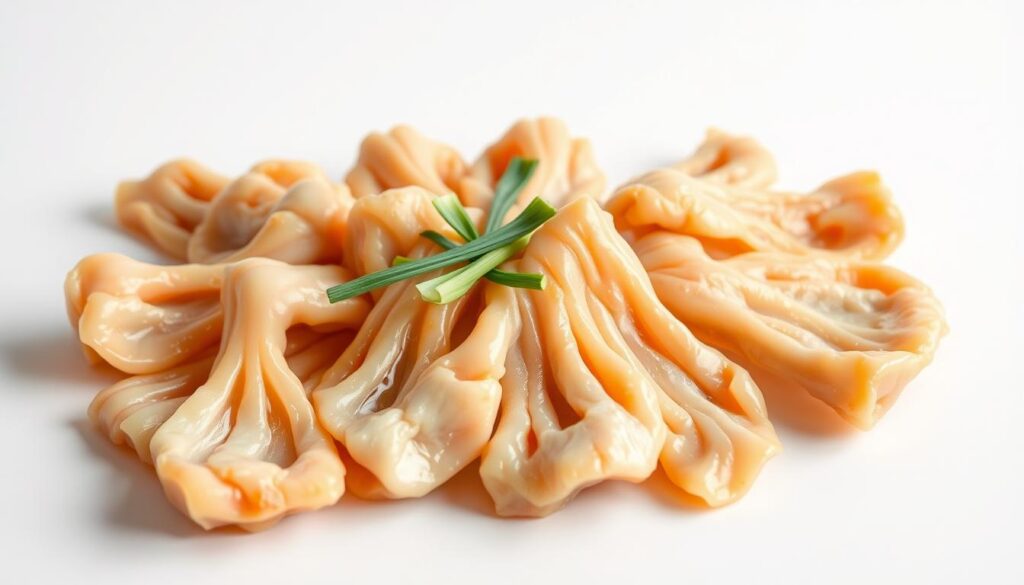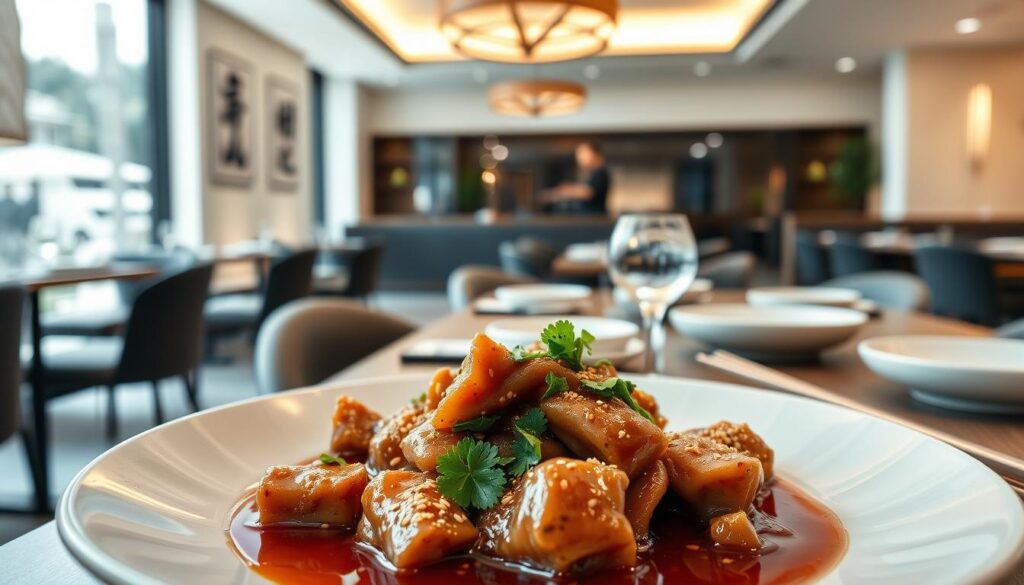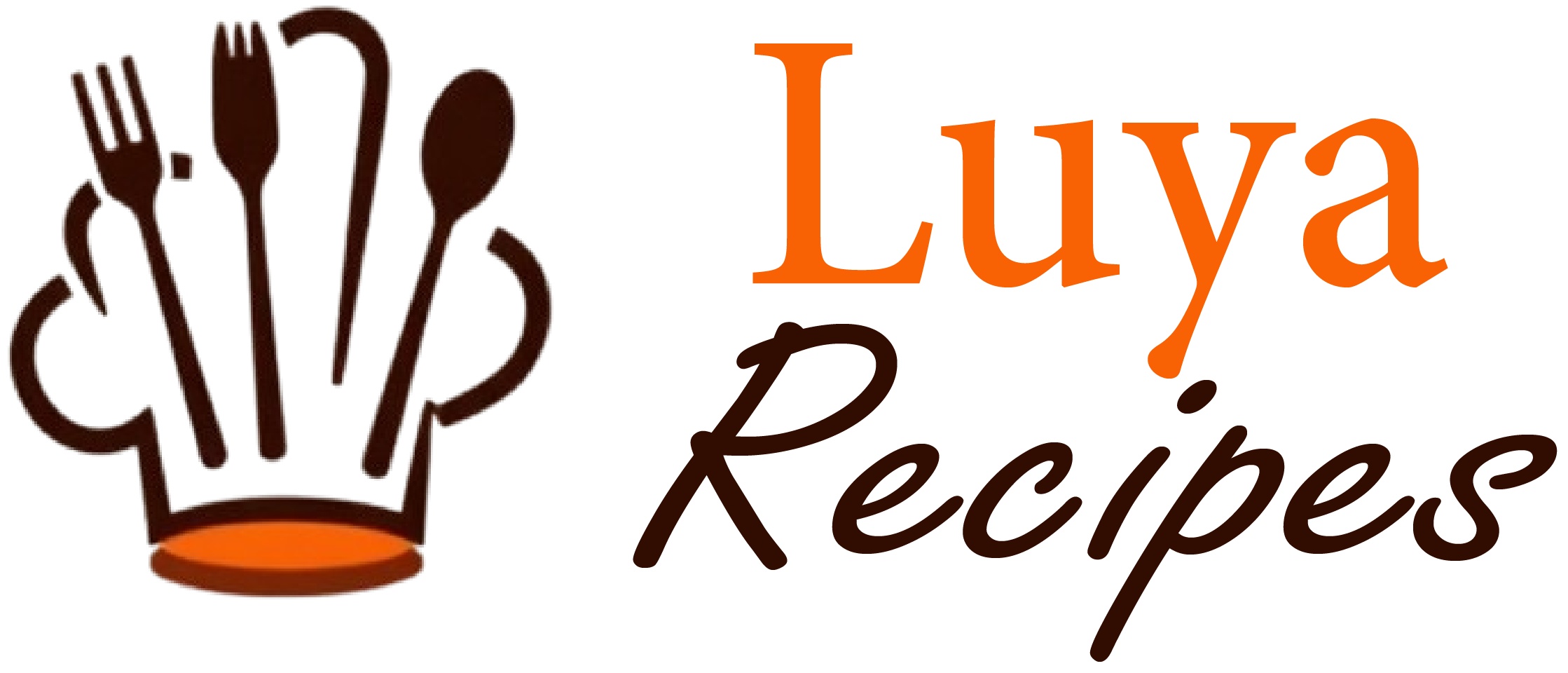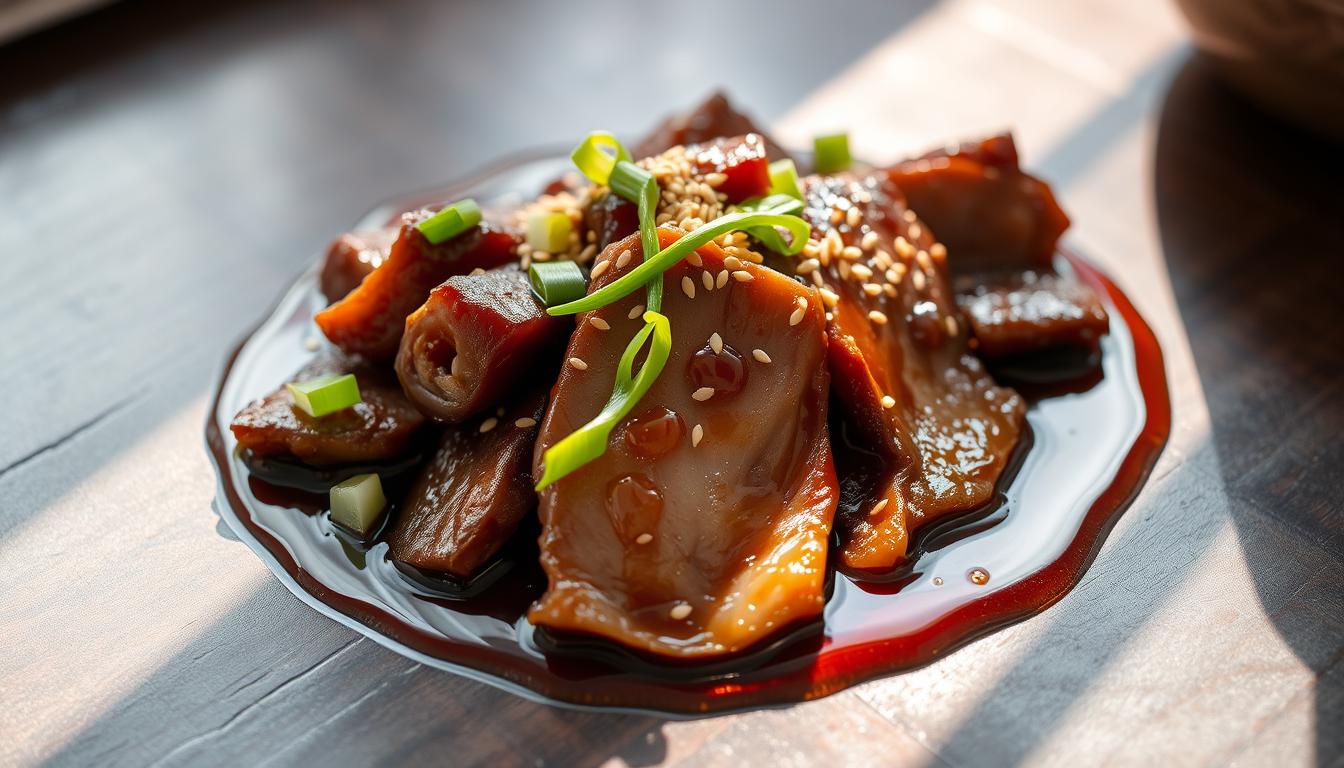Growing up in a traditional Chinese household, I remember the rich aroma of slow-cooked dishes. These dishes turned tough ingredients into culinary masterpieces. Chinese beef tendon was one such magical ingredient that captured my imagination.
It’s a humble cut that tells a story of patience, skill, and deep cultural respect for food. Chinese beef tendon is more than just a protein ingredient. It’s a testament to the culinary wisdom that transforms what others might discard into a delicacy.
This remarkable cut of meat embodies the Chinese cooking philosophy. It uses every part of an ingredient with respect and creativity. Imagine a delicacy that absorbs flavors like a sponge while offering an incredibly unique texture.
The authentic Chinese beef tendon recipe is not just a meal. It’s a journey through centuries of cooking tradition. It celebrates resourcefulness and flavor innovation.
Table of Contents
Understanding the Cultural Significance of Beef Tendon in Chinese Cuisine
Chinese cuisine values every ingredient deeply, turning tough cuts like beef tendon into culinary wonders. Cooking beef tendon is more than just food; it’s a cultural philosophy.
The art of cooking beef tendon in Chinese cuisine shows a deep understanding passed down through generations. Traditionally, Chinese communities used every part of an animal, reducing waste.
Traditional Preservation Methods
Beef tendon preservation shows incredible creativity:
- Sun-drying techniques to extend meat preservation
- Salt-curing methods for enhancing flavor
- Slow-cooking processes to tenderize tough meat cuts
The Philosophy of “Waste Not, Want Not”
The core of beef tendon cooking is rooted in the Japanese concept of mottainai. It’s about respecting ingredients and reducing waste. This turns a less desirable cut into a delicacy with careful cooking.
Regional Variations Across China
China’s different regions have their own ways of cooking beef tendon, showing local traditions:
- Sichuan: Spicy braised preparations
- Cantonese: Delicate slow-cooked stews
- Northern regions: Hearty, robust cooking styles
Each region’s take on beef tendon cooking shows its versatility and cultural importance in Chinese food.
What Makes Chinese Beef Tendon a Unique Delicacy
Chinese beef tendon is a culinary gem. It turns from tough to tender through special cooking methods. Its unique texture and flavor-absorbing abilities make it stand out.
The secret of beef tendon is its collagen. Slow cooking breaks down the collagen into a smooth, gel-like texture. Cooking for at least four hours is key to getting it just right.
- Primarily composed of collagen
- Requires extensive slow cooking
- Rich in essential nutrients
- Extremely low in fat
Beef tendon is also very nutritious. A 100g serving has about 30g of protein, less than 1g of fat, and only 150 kcal. It’s great for athletes and health lovers because of its amino acids, which help with joint and muscle health.
| Cooking Method | Time Required | Texture Result |
|---|---|---|
| Slow Simmering | 3-4 hours | Extremely Tender |
| Pressure Cooking | 45-60 minutes | Firm with Slight Bite |
| Slow Cooker | 6-8 hours | Melt-in-Mouth Texture |
Preparing beef tendon needs patience and care. Rinsing and blanching for three minutes can reduce its strong beefy aroma. Cooking at 190-200°F ensures the best result.
Essential Preparation Techniques for Perfect Beef Tendon
Learning to cook Chinese beef tendon is all about mastering certain steps. These steps turn tough connective tissue into a tasty treat. The traditional recipe needs patience and care to get it just right.
When you start with beef tendons, cleanliness and soaking are key. Here are the main steps to follow:
- Rinse the tendons well under cold water
- Soak them for 30-60 minutes to clean them
- Trim off any extra fat or unwanted parts
Cleaning and Soaking Methods
The double-boiling method is vital for cooking Chinese beef tendon. First, blanch the tendons in boiling water for 5-10 minutes. This step gets rid of bad tastes and prepares the tendon for more cooking.
The Double-Boiling Process
After blanching, use a pressure cooker for the best results. Cooking times depend on how tender you want the tendon:
- Firm and chewy: 45-60 minutes
- Tender with slight bite: 60-90 minutes
- Extremely tender: 90+ minutes
Achieving the Ideal Texture
Keeping the temperature right is key for beef tendons. Use a pressure cooker at high pressure for 15-20 minutes. Then, let it release naturally for 10-15 minutes. Look for a color change and a clearer look.
“The secret to perfect beef tendon lies in patience and precise cooking techniques.” – Traditional Chinese Cooking Wisdom
For your traditional Chinese beef tendon recipe, add classic spices. Use garlic, ginger, star anise, and cinnamon to boost the flavor.
Chinese Beef Tendon: A Nutritional Powerhouse
Explore the amazing world of chinese beef tendon. It’s a culinary gem that’s packed with nutrients. This ingredient goes from being a simple protein to a health powerhouse that can change your diet.
Chinese beef tendon is a nutritional goldmine. A 100g serving has about 30g of protein. It has less than 1g of fat and no carbs. It’s perfect for those who work out or follow specific diets.
- High protein content supporting muscle development
- Rich in collagen for joint and skin health
- Low in calories (around 150 kcal per 100g serving)
- Contains essential amino acids like glycine and proline
The collagen in beef tendon is key for connective tissue health. Adding it to your meals means you’re not just eating well. You’re also investing in your body’s health for the long term.
Cooking beef tendon thoroughly transforms its tough texture into a tender, gelatinous delicacy that’s both nutritious and satisfying.
If you care about your health or love trying new foods, chinese beef tendon is for you. It combines great taste with amazing nutrition, making it a top choice for your meals.
Popular Chinese Beef Tendon Cooking Methods
Chinese cuisine turns beef tendon into a work of art with different cooking methods. From simmering chinese beef tendon soup to rich braised dishes, these techniques show the ingredient’s versatility and flavor.
Learning about these cooking methods can make your chinese beef tendon stew amazing. Each method needs special skills and techniques to bring out the ingredient’s unique texture and taste.
Braising Techniques
Braising beef tendon takes patience and precision. Traditional methods include:
- Slow cooking at low temperatures
- Using aromatic spices like star anise and cinnamon
- Simmering in rich soy-based liquids
Soup-Based Preparations
Chinese beef tendon soup is a comforting tradition. The cooking process usually involves:
- Double-boiling to remove impurities
- Simmering with aromatic herbs
- Creating a collagen-rich broth
Hot Pot Variations
Hot pot cooking makes dining interactive with beef tendon. Diners can enjoy tender, flavorful pieces cooked right at the table. It shows the ingredient’s flexibility in Chinese cuisine.
Cooking beef tendon is an art that transforms tough connective tissue into a melt-in-your-mouth delicacy.
Selecting and Storing Fresh Beef Tendon

Choosing and keeping chinese beef tendon fresh is important. Look for cuts that are clean, pale, and have little fat. They should feel firm but a bit elastic, showing they’re fresh.
Storing beef tendon right is key to keeping it good. Raw tendons can last 1-2 days in the fridge if stored well. Here are some tips for keeping them fresh:
- Wrap beef tendon tightly in butcher paper or plastic wrap
- Store in the coldest part of your refrigerator
- Keep the tendon away from other raw meats to prevent cross-contamination
Freezing is great for keeping beef tendon longer. It can last up to 3-4 months in the freezer. Pro tip: Portion the tendons before freezing to make future cooking more convenient.
When you’re ready to cook, thaw frozen beef tendon in the fridge overnight. This slow thaw keeps the texture right and stops bacteria from growing. Before cooking, rinse the tendon in cold water and cut off any extra connective tissue for the best taste.
Remember, the key to exceptional chinese beef tendon dishes starts with selecting and storing high-quality meat.
Pairing Chinese Beef Tendon with Traditional Ingredients
Learning to pair chinese beef tendon dishes is all about finding the right balance. It’s a journey that shows how this unique protein can bring out the best in other ingredients. It adds depth and flavor in a way that’s truly remarkable.
Complementary Spices and Seasonings
The secret to great chinese beef tendon noodles is in their ability to take on complex flavors. A classic mix might include:
- Garlic and ginger for an aromatic base
- Star anise for warm, sweet notes
- Cinnamon for added depth
- Soy sauce for a rich umami taste
Side Dish Recommendations
Choosing the right sides can take your chinese beef tendon dish to the next level. Here are some traditional pairings to try:
| Side Dish | Flavor Profile | Recommended Preparation |
|---|---|---|
| Steamed Bok Choy | Light, Crisp | Lightly seasoned with sesame oil |
| Pickled Vegetables | Tangy, Refreshing | Quick pickle with rice vinegar |
| Jasmine Rice | Neutral, Soft | Steamed plain |
Exploring chinese beef tendon noodles is a journey for your senses. Mastering these pairing techniques turns every meal into a memorable experience. Each ingredient works together to create a dish that’s both harmonious and delicious.
Modern Interpretations of Classic Beef Tendon Dishes

Today, chefs are making the authentic chinese beef tendon recipe fresh again. They turn old recipes into new, exciting dishes. This shows how versatile beef tendon is, while keeping its cultural roots alive.
The best chinese beef tendon dish now comes from mixing old ways with new tastes. Chefs try out new combinations that make this classic ingredient even more special.
- Molecular Gastronomy Techniques: Transforming beef tendon into delicate foams and crispy textures
- Global Fusion Approaches: Incorporating beef tendon into international cuisine styles
- Artistic Plating: Presenting beef tendon dishes with contemporary visual appeal
Some chefs use sous-vide to make beef tendon super tender. Others add it to dishes like gourmet tacos or fusion appetizers. Michelin-starred restaurants are great at making this traditional ingredient into a fancy dish that wows people.
Young chefs are trying new things with beef tendon. They use techniques like nitrogen freezing or make beef tendon chips for a new texture. These new takes on beef tendon keep its traditional charm but also offer exciting new ways to enjoy it.
Conclusion
Exploring Chinese beef tendon cuisine shows us a treasure beyond just an ingredient. It’s packed with nutritional value and holds deep cultural significance. With about 30g of protein per 100g and almost no fat, it’s a great choice for those watching their diet.
The variety in using beef tendon is vast, from traditional dishes to new recipes. You can cook it slowly or under pressure, showing its flexibility. It’s perfect for athletes looking for joint health or anyone wanting to try Asian cooking.
Beef tendon is more than a protein; it’s a link to Chinese cooking history. It shows the value of using every part of an ingredient. Learning about its preparation, nutrition, and cultural role opens up a new appreciation for it.
Start your journey into beef tendon with an open mind and a sense of wonder. Try different cooking ways, check out local recipes, and enjoy its unique taste and texture. Your culinary adventure is just starting.
FAQ
What exactly is Chinese beef tendon?
Chinese beef tendon is a part of beef that’s loved for its soft texture. It’s made from beef connective tissue. When cooked right, it’s tender and soaks up flavors well. It’s a favorite in soups, stews, and braises.
How long does it take to cook beef tendon to make it tender?
Cooking beef tendon takes a long time, usually 2-4 hours. Methods like double-boiling or braising break down the tough parts. This turns the tendon into a soft, delicious treat.
Is beef tendon nutritionally beneficial?
Yes, beef tendon is very nutritious. It’s full of collagen, amino acids, and protein. The collagen can help with joint health, skin, and even aging.
What are the most popular ways to prepare beef tendon in Chinese cuisine?
Beef tendon is often braised in sauces, made into soups, or added to hot pots. It’s also used in noodle dishes. Each way shows off its flavor-absorbing and texture-changing abilities.
How should I store fresh beef tendon?
Keep fresh beef tendon in the fridge for 1-2 days. Freeze it for up to 3 months if you won’t use it soon. Always wrap it well to avoid freezer burn.
What ingredients pair well with beef tendon?
Spices like star anise, Sichuan peppercorns, ginger, and soy sauce go great with beef tendon. It also pairs well with root veggies, radishes, and green onions in different dishes.
Is beef tendon considered a delicacy in all regions of China?
Beef tendon is enjoyed across China, but differently. Sichuan loves spicy tendon dishes, while Cantonese cuisine prefers slow-cooked, delicate versions.
Can beef tendon be part of a modern, fusion cuisine?
Yes! Modern chefs are using beef tendon in new, exciting ways. They mix traditional cooking with modern flavors, creating unique dishes.
How can I ensure my beef tendon is perfectly cooked?
Cooking beef tendon needs patience and slow cooking. Clean it well, then use double-boiling or braising. It should be soft and easy to pull apart when done.
Are there any vegetarian alternatives to beef tendon?
No exact veggie substitute exists, but seitan or tofu can mimic its texture. Yet, they won’t have the same taste or nutrition as beef tendon.
Source Links
- Sweet and Savory Caramelized Beef Tendon(Shigureni) – https://marcsrecipes.com/sweet-and-savory-caramelized-beef-tendon-shigureni/
- Chinese Beef Stew (Authentic Recipe) – https://pupswithchopsticks.com/chinese-braised-beef-stew/
- Chongqing Blanket Noodles With Stewed Beef (Niurou Pugaimian, 牛肉铺盖面) – https://blog.themalamarket.com/handmade-blanket-noodles-with-stewed-beef-niurou-pugaimian/
- Chinese Dishes | TikTok – https://www.tiktok.com/channel/chinese-dishes
- The 2-Step Prep Process You Need To Cook Beef Tendon – Tasting Table – https://www.tastingtable.com/1693575/beef-tendon-what-is-it-how-to-cook/
- Beef Tendon Powerful Benefits, Cooking Tips March 18, 2025 – https://www.dailyrecipespro.com/beef-tendon-cooking-tips-recipes/
- Master Beef Tendon Cooking in 20-minute | The Bright Food – https://www.thebrightfood.com/master-beef-tendon-cooking-in-20-minute/
- Beef tendon and bone marrow noodle soup – https://umamidays.com/beef-tendon-bone-marrow-noodle-soup/
- Braised Beef Tendon Pares: A Slow-Cooked Delight ~ Relax Lang Mom – https://relaxlangmom.com/braised-beef-tendon-a-slow-cooked-delight/
- Buy Tendon near me with free delivery – https://www.sayweee.com/en/grocery-near-me/lang-en/explore/tendon
- Featured on Tastemade: Traditional Beef Pho Bo with Oxtail – Poppa Trinh’s Pho Tai Recipe — WHISKEY & BOOCH – https://www.whiskeyandbooch.com/blog/pho-bo-with-oxtail-and-tendons-badre
- The 6 Best Beef Noodles in Taipei (+ 4 notable mentions) – Taiwan Obsessed – https://www.taiwanobsessed.com/best-beef-noodles-taipei/
- What to Eat in Nagoya: The Industrial Powerhouse – https://www.byfood.com/blog/nagoya/what-to-eat-in-nagoya









